Wu Song-ming (吳松明) started making woodblock prints in the late 1990s because his art school teachers told him that he was rubbish at oil painting, the discipline he was majoring in. Now he makes a living from his art, an enviable situation for a 46-year-old artist working in an unfashionable medium.
Wu’s new works, the majority of which are scenes of Taiwan in black ink, go on show in Living Under the Longan Tree (龍眼樹下), an exhibition at the German Cultural Center from next Monday. Wu’s aim for the series is simple: “To make people take a second look at the things around them.”
Hailing from a farming family on Taiwan’s northeast coast, Wu came late to art school, after making a number of attempts to get the required grades. “I was shattered that my oil paintings were taken apart by my teachers time and time again,” he said. To find consolation, he took up wood sculpture, then found a comfortable niche in woodblock printing, where he could combine his newfound medium with his desire to paint.
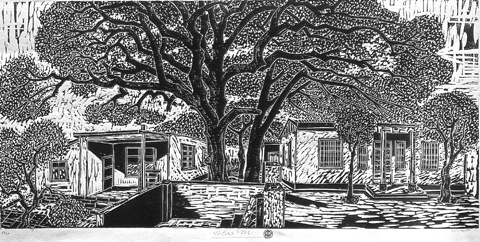
PHOTO: COURTESY OF WU SONG-MING
“Woodblock printing hardly needs to be taught because it’s so simple,” he said with a laugh, adding that it is the immediacy of the medium that appeals to him.
With woodblock printing, Wu said he experiences a palpable and delightful feeling of the theoretical baggage that burdened him during art school falling away.
“I want to express things that I see and experience in my own language,” he said. “With Western oil painting, I knew so much about it, the history and techniques, it just got in the way. I knew nothing about woodwork, but I found it really easy and fun to work in this medium.” It proved a recipe for success.
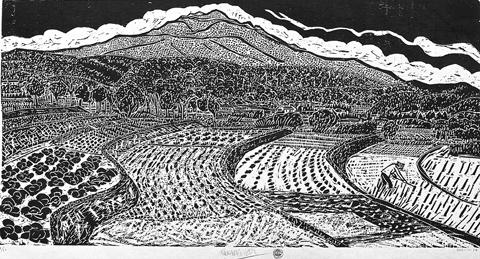
PHOTO: COURTESY OF WU SONG-MING
Wu’s earlier work, some of which was inspired by his experiences traveling in Europe during an art residency there, have an Expressionistic quality, and though he is interested the woodblock work of post-Impressionists such as Gauguin and also the German Expressionists, who worked with woodblock printing, he denies being directly influenced by them.
Although his new series Living Under the Longan Tree takes Taiwan as its theme, Wu shuns political baggage and aims to keep his distance from Chinese artistic traditions as well.
“At school, it was all about learning from books, you didn’t have to look at anything to be able to paint it,” he said.
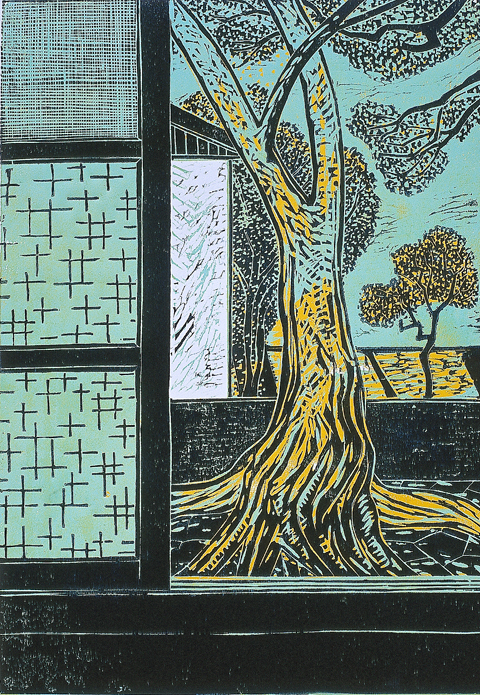
PHOTO: COURTESY OF WU SONG-MING
“Technically, woodblock printing is fairly simple, and doesn’t require expensive equipment,” Wu said, which explains how he’s been able to alternate regularly between production and exhibiting with an ease denied to more academically respectable and technically demanding mediums such as etching.
In Living Under the Longan Tree, Wu takes a close look at the scenery of his home and finds a challenge in learning how to represent the things he sees. “I will probably return to doing abstract work. But working from nature is like returning to base; it forces me to really look at things closely and work out how to express them. Imagination is like a space shuttle; it can wander to incredibly distant places, but sometimes it’s got to come back to refuel.”
This process of refueling has produced some delightful images of Taiwan. They are stylistically androgynous, with tantalizing hints of both Western and Asian influences, and in their painstaking detail and evocative composition, manage to be recognizable without completely giving up an allegorical element.
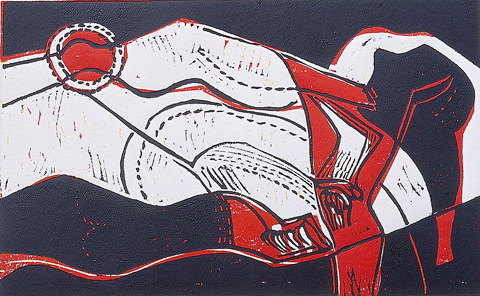
PHOTO: COURTESY OF WU SONG-MING
In the huge House With Longan Tree (有龍眼樹的住所), which measures 90cm by 45cm, from which the title of the exhibition is taken, Wu has depicted his own studio in Beitou District, Taipei City. “These are things that are right in front of me. This is the opposite of trying to show off my knowledge or my technical skill; all I want to show is a natural composition, and show how beautiful this composition can be. Perhaps then I will make people take a second look at the things that are around them, and realize the beauty of what they see.”
In another large work, Under Seven Star Mountain (七星山下), the composition, with terraced fields forming orderly rows beneath the gentle peak of Taipei’s Seven Star Mountain, is suggestive of a traditional altar laden with offerings, forming a balance between the representational and Expressionistic.
“In art school, we absorbed huge amounts of theory about the Western artistic tradition, but this tradition was not my native language; we can learn it, even become adept, but it is never our native language,” Wu said. With these new prints, he has clearly created, if not his own language, at least a fascinating and appealing argot.
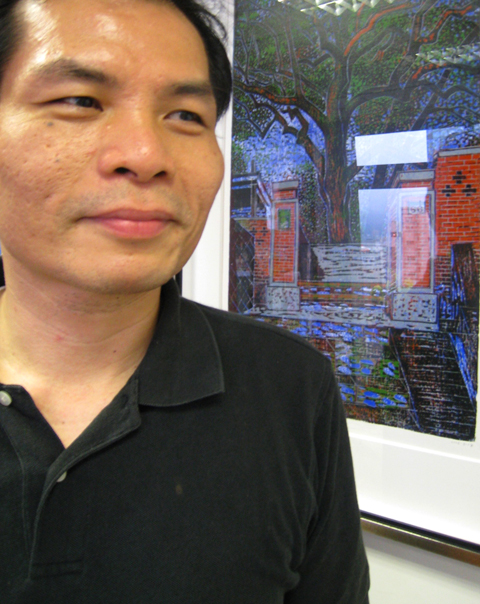
PHOTO: IAN BARTHOLOMEW, TAIPEI TIMES

“Why does Taiwan identity decline?”a group of researchers lead by University of Nevada political scientist Austin Wang (王宏恩) asked in a recent paper. After all, it is not difficult to explain the rise in Taiwanese identity after the early 1990s. But no model predicted its decline during the 2016-2018 period, they say. After testing various alternative explanations, Wang et al argue that the fall-off in Taiwanese identity during that period is related to voter hedging based on the performance of the Democratic Progressive Party (DPP). Since the DPP is perceived as the guardian of Taiwan identity, when it performs well,

The Taiwan People’s Party (TPP) on May 18 held a rally in Taichung to mark the anniversary of President William Lai’s (賴清德) inauguration on May 20. The title of the rally could be loosely translated to “May 18 recall fraudulent goods” (518退貨ㄌㄨㄚˋ!). Unlike in English, where the terms are the same, “recall” (退貨) in this context refers to product recalls due to damaged, defective or fraudulent merchandise, not the political recalls (罷免) currently dominating the headlines. I attended the rally to determine if the impression was correct that the TPP under party Chairman Huang Kuo-Chang (黃國昌) had little of a

At Computex 2025, Nvidia CEO Jensen Huang (黃仁勳) urged the government to subsidize AI. “All schools in Taiwan must integrate AI into their curricula,” he declared. A few months earlier, he said, “If I were a student today, I’d immediately start using tools like ChatGPT, Gemini Pro and Grok to learn, write and accelerate my thinking.” Huang sees the AI-bullet train leaving the station. And as one of its drivers, he’s worried about youth not getting on board — bad for their careers, and bad for his workforce. As a semiconductor supply-chain powerhouse and AI hub wannabe, Taiwan is seeing

Jade Mountain (玉山) — Taiwan’s highest peak — is the ultimate goal for those attempting a through-hike of the Mountains to Sea National Greenway (山海圳國家綠道), and that’s precisely where we’re headed in this final installment of a quartet of articles covering the Greenway. Picking up the trail at the Tsou tribal villages of Dabang and Tefuye, it’s worth stocking up on provisions before setting off, since — aside from the scant offerings available on the mountain’s Dongpu Lodge (東埔山莊) and Paiyun Lodge’s (排雲山莊) meal service — there’s nowhere to get food from here on out. TEFUYE HISTORIC TRAIL The journey recommences with